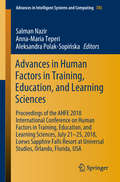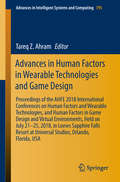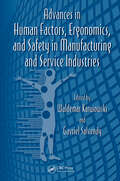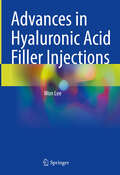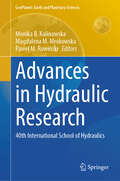- Table View
- List View
Advances in Human Factors in Training, Education, and Learning Sciences: Proceedings of the AHFE 2018 International Conference on Human Factors in Training, Education, and Learning Sciences, July 21-25, 2018, Loews Sapphire Falls Resort at Universal Studios, Orlando, Florida, USA (Advances in Intelligent Systems and Computing #785)
by Salman Nazir Anna-Maria Teperi Aleksandra Polak-SopińskaThis book focuses on the importance of human factors in optimizing the learning and training process. It reports on the latest research and best practices and discusses key principles of behavioral and cognitive science, which are extremely relevant to the design of instructional content and new technologies to support mobile and multimedia learning, virtual training and web-based learning, among others, as well as performance measurements, social and adaptive learning and many other types of educational technologies, with a special emphasis on those important in the corporate, higher education, and military training contexts. Based on the AHFE 2018 Conference on Human Factors in Training, Education, and Learning Sciences, held July 21–25, 2018 in Orlando, Florida, USA on July 21–25, 2018, the book offers a timely perspective on the role of human factors in education. It highlights important new ideas and will fosters new discussions on how to optimally design learning experiences.
Advances in Human Factors in Training, Education, and Learning Sciences: Proceedings of the AHFE 2019 International Conference on Human Factors in Training, Education, and Learning Sciences, July 24-28, 2019, Washington D.C., USA (Advances in Intelligent Systems and Computing #963)
by Salman Nazir Waldemar Karwowski Tareq AhramThis book focuses on the importance of human factors in optimizing the learning and training process. It reports on the latest research and best practices and discusses key principles of behavioral and cognitive science, which are extremely relevant to the design of instructional content and new technologies to support mobile and multimedia learning, virtual training and web-based learning, among others, as well as performance measurements, social and adaptive learning and many other types of educational technologies, with a special emphasis on those important in the corporate, higher education, and military training contexts. Based on the AHFE 2019 Conference on Human Factors in Training, Education, and Learning Sciences, held on July 24-28, 2019, in Washington D.C., USA, the book offers a timely perspective on the role of human factors in education. It highlights important new ideas and will fosters new discussions on how to optimally design learning experiences.
Advances in Human Factors in Training, Education, and Learning Sciences: Proceedings of the AHFE 2020 Virtual Conference on Human Factors in Training, Education, and Learning Sciences, July 16-20, 2020, USA (Advances in Intelligent Systems and Computing #1211)
by Salman Nazir Waldemar Karwowski Tareq AhramThis book addresses the importance of human factors in optimizing the learning and training process. It reports on the latest research and best practices, and discusses key principles of behavioral and cognitive science, which are extremely relevant to the design of instructional content and new technologies to support mobile and multimedia learning, virtual training and web-based learning, among others, as well as performance measurements, social and adaptive learning and many other types of educational technology, with a special emphasis on those important in the corporate, higher education, healthcare and military training contexts. Gathering contributions to the AHFE 2020 Virtual Conference on Human Factors in Training, Education, and Learning Sciences, held on July 16–20, 2020, the book offers a timely perspective on the role of human factors in education. It highlights important new approaches and ideas, and fosters new discussions on how to optimally design learning experiences.
Advances in Human Factors in Training, Education, and Learning Sciences: Proceedings of the AHFE 2021 Virtual Conference on Human Factors in Training, Education, and Learning Sciences, July 25-29, 2021, USA (Lecture Notes in Networks and Systems #269)
by Salman Nazir Waldemar Karwowski Tareq Z. AhramThis book addresses the importance of human factors in optimizing the learning and training process. It reports on the latest research and best practices relating to the application of behavioral and cognitive science, and new technologies in the design of instructional and training content. It proposes innovative strategies for improving the learning and training experience and outcomes in different contexts, including lower and higher education, and different industry sectors. A special emphasis is given to digital and distance learning, gamification, and virtual training. Gathering contributions to the AHFE 2021 Conference on Human Factors in Training, Education, and Learning Sciences, held virtually on July 25-29, 2021, from USA, this book offers extensive information and a thought-provoking guide for both researchers and practitioners in the field of education and training.
Advances in Human Factors in Wearable Technologies and Game Design: Proceedings of the AHFE 2017 International Conference on Advances in Human Factors and Wearable Technologies, July 17-21, 2017, The Westin Bonaventure Hotel, Los Angeles, California, USA (Advances in Intelligent Systems and Computing #608)
by Tareq Ahram Christianne FalcãoThis book focuses on the human aspects of wearable technologies and game design, which are often neglected. It shows how user centered practices can optimize wearable experience, thus improving user acceptance, satisfaction and engagement towards novel wearable gadgets. It describes both research and best practices in the applications of human factors and ergonomics to sensors, wearable technologies and game design innovations, as well as results obtained upon integration of the wearability principles identified by various researchers for aesthetics, affordance, comfort, contextual-awareness, customization, ease of use, ergonomy, intuitiveness, obtrusiveness, information overload, privacy, reliability, responsiveness, satisfaction, subtlety, user friendliness and wearability. The book is based on the AHFE 2017 Conferences on Human Factors and Wearable Technologies and AHFE 2017 Conferences on Human Factors and Game Design, held on July 17-21, 2017, in Los Angeles, California, USA, and addresses professionals, researchers, and students dealing with the human aspects of wearable, smart and/or interactive technologies and game design research.
Advances in Human Factors in Wearable Technologies and Game Design: Proceedings of the AHFE 2018 International Conferences on Human Factors and Wearable Technologies, and Human Factors in Game Design and Virtual Environments, Held on July 21–25, 2018, in Loews Sapphire Falls Resort at Universal Studios, Orlando, Florida, USA (Advances in Intelligent Systems and Computing #795)
by Tareq Z. AhramThis book focuses on the human aspects of wearable technologies and game design, which are often neglected. It shows how user centered practices can optimize wearable experience, thus improving user acceptance, satisfaction and engagement towards novel wearable gadgets. It describes both research and best practices in the applications of human factors and ergonomics to sensors, wearable technologies and game design innovations, as well as results obtained upon integration of the wearability principles identified by various researchers for aesthetics, affordance, comfort, contextual-awareness, customization, ease of use, ergonomy, intuitiveness, obtrusiveness, information overload, privacy, reliability, responsiveness, satisfaction, subtlety, user friendliness and wearability. The book is based on the AHFE 2018 Conference on Human Factors and Wearable Technologies and the AHFE 2018 Conference on Human Factors in Game Design and Virtual Environments , held on July 21–25, 2018 in Orlando, Florida, and addresses professionals, researchers, and students dealing with the human aspects of wearable, smart and/or interactive technologies and game design research.
Advances in Human Factors in Wearable Technologies and Game Design: Proceedings of the AHFE 2019 International Conference on Human Factors and Wearable Technologies, and the AHFE International Conference on Game Design and Virtual Environments, July 24-28, 2019, Washington D.C., USA (Advances in Intelligent Systems and Computing #973)
by Tareq AhramThis book focuses on the human aspects of wearable technologies and game design, which are often neglected. It shows how user-centered practices can optimize the wearable experience, thus improving user acceptance, satisfaction and engagement with novel wearable gadgets. It addresses both research and best practices in the applications of human factors and ergonomics to sensors, wearable technologies and game design innovations, as well as new findings on the integration of wearability principles with regard to: aesthetics, affordance, comfort, contextual awareness, customization, ease of use, ergonomics, information overload, intuitiveness, obtrusiveness, privacy, reliability, responsiveness, satisfaction, subtlety, user-friendliness and wearability. Gathering the outcomes of both the AHFE 2019 Conference on Human Factors and Wearable Technologies and the AHFE 2019 Conference on Human Factors in Game Design and Virtual Environments, held on July 24–28, 2019 in Washington, DC, USA, the book addresses the needs of professionals, researchers, and students whose work involves the human aspects of wearable, smart and/or interactive technologies and game design research.
Advances in Human Factors of Transportation: Proceedings of the AHFE 2019 International Conference on Human Factors in Transportation, July 24-28, 2019, Washington D.C., USA (Advances in Intelligent Systems and Computing #964)
by Neville StantonThis book discusses the latest advances in research and development, design, operation and analysis of transportation systems and their complementary infrastructures. It reports on both theories and case studies on road and rail, aviation and maritime transportation. Further, it covers a wealth of topics, from accident analysis, vehicle intelligent control, and human-error and safety issues to next-generation transportation systems, model-based design methods, simulation and training techniques, and many more. A special emphasis is placed on smart technologies and automation in transport, and on the user-centered, ergonomic and sustainable design of transport systems. The book, which is based on the AHFE 2019 International Conference on Human Factors in Transportation, held on July 24-28, 2019, in Washington D.C., USA, mainly addresses the needs of transportation system designers, industrial designers, human–computer interaction researchers, civil and control engineers, as well as vehicle system engineers. Moreover, it represents a timely source of information for transportation policy-makers and social scientists whose work involves traffic safety, management, and sustainability issues in transport.
Advances in Human Factors, Business Management and Leadership: Proceedings Of The Ahfe 2017 Conference On Human Factors, Business Management And Society And The Ahfe 2017 Conference On Human Factors In Management And Leadership, July 17-21, 2017, Los Angeles, California, Usa (Advances in Intelligent Systems and Computing #594)
by Jussi Ilari Kantola Salman NazirThis book presents practical approaches for facilitating the achievement of excellence in the management and leadership of organizational resources. It shows how the principles of creating shared value can be applied to ensure faster learning, training, business development, and social renewal. In particular, it presents novel methods and tools for tackling the complexity of management and learning in both business organizations and society. Discussing ontologies, intelligent management systems, methods for creating knowledge and value added, it offers novel insights into time management and operations optimization, as well as advanced methods for evaluating customers’ satisfaction and conscious experience. Based on two conferences, the AHFE 2019 International Conference on Human Factors, Business Management and Society, and the AHFE 2019 International Conference on Human Factors in Management and Leadership, held in July 24-28, 2019, Washington D.C., USA, the book provides both researchers and professionals with new tools and inspiring ideas for achieving excellence in various business activities.
Advances in Human Factors, Business Management and Leadership: Proceedings of the AHFE 2020 Virtual Conferences on Human Factors, Business Management and Society, and Human Factors in Management and Leadership, July 16-20, 2020, USA (Advances in Intelligent Systems and Computing #1209)
by Jussi Ilari Kantola Salman Nazir Vesa SalminenThis book analyzes new theories and practical approaches for promoting excellence in human resource management and leadership. It shows how the principles of creating shared value can be applied to ensure faster learning, training, business development and social renewal. In particular, it presents novel methods and tools for tackling the complexity of management and learning in both business organizations and society. Discussing ontologies, intelligent management systems, and methods for creating knowledge and value added, it offers novel insights into time management and operations optimization, as well as advanced methods for evaluating customers’ satisfaction and conscious experience. Based on three AHFE 2020 Virtual Conferences: the AHFE 2020 Conference on Human Factors, Business Management and Society, the AHFE 2020 Conference on Human Factors in Management and Leadership, held on July 16–20, 2020, the book provides researchers and professionals with extensive information, practical tools and inspiring ideas for achieving excellence in a broad spectrum of business and societal activities.
Advances in Human Factors, Business Management and Leadership: Proceedings of the AHFE 2021 Virtual Conferences on Human Factors, Business Management and Society, and Human Factors in Management and Leadership, July 25-29, 2021, USA (Lecture Notes in Networks and Systems #267)
by Jussi Ilari Kantola Salman Nazir Vesa SalminenThis book analyzes new theories and practical approaches for promoting excellence in human resource management and leadership. It shows how the principles of creating shared value can be applied to ensure faster learning, training, business development and social renewal. In particular, it presents novel methods and tools for tackling the complexity of management and learning in both business organizations and society. Gathering the proceedings of the AHFE 2021 Conferences on Human Factors, Business Management and Society, and Human Factors in Management and Leadership, held virtually on July 25–29, 2021, from USA, this book provides researchers and professionals with extensive information, practical tools and inspiring ideas for achieving excellence in a broad spectrum of business and societal activities.
Advances in Human Factors, Business Management and Society: Proceedings of the AHFE 2018 International Conference on Human Factors, Business Management and Society, July 21-25, 2018, Loews Sapphire Falls Resort at Universal Studios, Orlando, Florida, USA (Advances in Intelligent Systems and Computing #783)
by Jussi Ilari Kantola Tibor Barath Salman NazirThis book presents practical approaches for facilitating the achievement of excellence in the management and leadership of organizational resources. It shows how the principles of creating shared value can be applied to ensure faster learning, training, business development, and social renewal. In particular, it presents novel methods and tools for tackling the complexity of management and learning in both business organizations and society. Discussing ontologies, intelligent management systems, methods for creating knowledge and value added, it offers novel insights into time management and operations optimization, as well as advanced methods for evaluating customers’ satisfaction and conscious experience. Based on two conferences, the AHFE 2018 International Conference on Human Factors, Business Management and Society, and the AHFE 2018 International Conference on Human Factors in Management and Leadership, held on July 21–25, 2018, in Orlando, Florida, USA, the book provides both researchers and professionals with new tools and inspiring ideas for achieving excellence in various business activities.
Advances in Human Factors, Business Management, Training and Education: Proceedings of the AHFE 2016 International Conference on Human Factors, Business Management and Society, July 27-31, 2016, Walt Disney World®, Florida, USA (Advances in Intelligent Systems and Computing #498)
by Jussi Ilari Kantola Tibor Barath Salman Nazir Terence AndreThis book reports on practical approaches for facilitating the process of achieving excellence in the management and leadership of organizational resources. It shows how the principles of creating shared value can be applied to ensure faster learning, training, business development, and social renewal. In particular, the book presents novel methods and tools for tackling the complexity of management and learning in both business organizations and society. It covers ontologies, intelligent management systems, methods for creating knowledge and value added. It gives novel insights into time management and operations optimization, as well as advanced methods for evaluating customers' satisfaction and conscious experience. Based on the AHFE 2016 International Conference on Human Factors, Business Management and Society, held on July 27-31, 2016, Walt Disney World®, Florida, USA, the book provides both researchers and professionals with new tools and inspiring ideas for achieving excellence in various business activities.
Advances in Human Factors, Ergonomics, and Safety in Manufacturing and Service Industries
by Gavriel Salvendy Waldemar KarwowskiThis volume is concerned with the human factors, ergonomics, and safety issues related to the design of products, processes, and systems, as well as operation and management of business enterprises in both manufacturing and service sectors of contemporary industry. The book is organized into ten sections that focus on the following subject matters:
Advances in Human Factors, Software, and Systems Engineering: Proceedings of the AHFE 2017 International Conference on Human Factors, Software, and Systems Engineering, July 17-21, 2017, The Westin Bonaventure Hotel, Los Angeles, California, USA (Advances in Intelligent Systems and Computing #598)
by Waldemar Karwowski Tareq AhramThis book provides a platform for addressing human factors in software and systems engineering, both pushing the boundaries of current research and responding to new challenges, fostering new research ideas in the process. Topics include evolutionary and complex systems, human systems integration, smart grids and infrastructure, workforce training requirements, systems engineering education, and defense and aerospace. Based on the AHFE 2017 International Conference on Human Factors, Software, and Systems Engineering, held on July 17-21, 2017, Los Angeles, USA, this book is an inspiring guide for all researchers and professionals in the field of human factors, software and systems engineering.
Advances in Human Factors, Sustainable Urban Planning and Infrastructure: Proceedings of the AHFE 2017 International Conference on Human Factors, Sustainable Urban Planning and Infrastructure, July 17−21, 2017, The Westin Bonaventure Hotel, Los Angeles, California, USA (Advances in Intelligent Systems and Computing #600)
by Jerzy CharytonowiczThis book deals with human factors research directed towards realizing and assessing sustainability in the built environment. It reports on advanced engineering methods for sustainable infrastructure design, as well as on assessments of the efficient methods and the social, environmental, and economic impact of various designs and projects. The book covers a range of topics, including the use of recycled materials in architecture, ergonomics in buildings and public design, sustainable design for smart cities, design for the aging population, industrial design, human scale in architecture, and many more. Based on the AHFE 2017 International Conference on Human Factors, Sustainable Urban Planning and Infrastructure, held on July 17-21, 2017, in Los Angeles, California, USA, this book, by showing different perspectives on sustainability and ergonomics, represents a useful source of information for designers in general, urban engineers, architects, infrastructure professionals, practitioners, public infrastructure owners, policy makers, government engineers and planners, as well as operations managers, and academics active in applied research.
Advances in Human Factors, Sustainable Urban Planning and Infrastructure: Proceedings of the AHFE 2018 International Conference on Human Factors, Sustainable Urban Planning and Infrastructure, July 21-25, 2018, Loews Sapphire Falls Resort at Universal Studios, Orlando, Florida, USA (Advances in Intelligent Systems and Computing #788)
by Jerzy Charytonowicz Christianne FalcãoThis book discusses human factors research directed towards realizing and assessing sustainability in the built environment. It reports on advanced engineering methods for sustainable infrastructure design, as well as on assessments of the efficient methods and the social, environmental, and economic impact of various designs and projects. The book covers a range of topics, including the use of recycled materials in architecture, ergonomics in buildings and public design, sustainable design for smart cities, design for the aging population, industrial design, human scale in architecture, and many more. Based on the AHFE 2018 International Conference on Human Factors, Sustainable Urban Planning and Infrastructure, held on July 21–25, 2018, in Orlando, Florida, USA, it offers various perspectives on sustainability and ergonomics. As such, it is a valuable reference resource for designers, urban engineers, architects, infrastructure professionals, public infrastructure owners, policy makers, government engineers and planners, as well as operations managers and academics active in urban and infrastructure research.
Advances in Hurricane Risk in a Changing Climate (Hurricane Risk #3)
by Paul Wilson Jennifer Collins James Done Yi-Jie ZhuTropical cyclones (including hurricanes) are becoming more destructive. Rising seas are resulting in greater storm surge inundation. More moisture-laden, warmer air is leading to heavier rains. There is also mounting evidence for more powerful winds and a greater incidence of the strongest storms. Do we fully understand these changes, and what will these changes mean for society? Arising from the 2024 Symposium on Hurricane Risk in a Changing Climate, this book contains new research on hurricane behavior, our vulnerability, and how we communicate the risk. This book is essential reading to understand the future of tropical cyclone risk and what it means for society.
Advances in Hyaluronic Acid Filler Injections
by Won LeeIn this book, we will delve into the latest advancements and discoveries in the field of hyaluronic acid filler injections. Hyaluronic acid filler injection stands out as one of the most frequently performed aesthetic procedures globally. The chapters within will encompass recent technological innovations related to hyaluronic acid fillers, encompassing key aspects such as rheology, cohesiveness, degree modification, NMR data, and information on impurities. Additionally, the book will feature up-to-date techniques for safe procedures employing Doppler ultrasound and explore potential treatments for ocular complications.
Advances in Hybrid Conducting Polymer Technology (Engineering Materials)
by Mohammad Khalid Syed Shahabuddin Adarsh Kumar Pandey Priyanka JagadishThis book presents synthesis methods, characterization techniques, properties and applications of hybrid conducting polymers. Special emphasis is given to the applications of hybrid conductive polymers, with chapters ranging from electronic devices, environmental remediation, and sensors, to medical applications.
Advances in Hybridization of Intelligent Methods: Models, Systems and Applications (Smart Innovation, Systems and Technologies #85)
by Vasile Palade Ioannis HatzilygeroudisThis book presents recent research on the hybridization of intelligent methods, which refers to combining methods to solve complex problems. It discusses hybrid approaches covering different areas of intelligent methods and technologies, such as neural networks, swarm intelligence, machine learning, reinforcement learning, deep learning, agent-based approaches, knowledge-based system and image processing. The book includes extended and revised versions of invited papers presented at the 6th International Workshop on Combinations of Intelligent Methods and Applications (CIMA 2016), held in The Hague, Holland, in August 2016. The book is intended for researchers and practitioners from academia and industry interested in using hybrid methods for solving complex problems.
Advances in Hydraulic Research: 40th International School of Hydraulics (GeoPlanet: Earth and Planetary Sciences)
by Paweł M. Rowiński Monika B. Kalinowska Magdalena M. MrokowskaThis book provides an overview of advances in experimental, numerical modelling, and theoretical aspects of environmental hydraulics. By highlighting the latest findings on processes in natural aquatic systems, solutions for civil engineering and water resources management, with a special focus on interdisciplinary cooperation between Earth scientists, ecologists, biologists and hydraulic engineers that have helped to mitigate the impacts of anthropopressure on river habitats, it provides both researchers and practitioners with first-hand information about the latest trends in hydraulic research. The book combines peer-reviewed versions of invited lectures and regular presentations at the 40th International School of Hydraulics, held May 23–26, 2023, in Kąty Rybackie, Poland. With contributions from world-leading experts and young researchers, many areas of environmental hydraulics are addressed here, including recent findings in numerical modelling and laboratory and field studies related to sediment and pollutant transport processes in rivers, fluvial morphodynamics, flow in vegetated channels, hydraulic structures in rivers and estuaries, and freshwater fish protection.
Advances in Hydraulic and Pneumatic Drives and Control 2020 (Lecture Notes in Mechanical Engineering)
by Jarosław Stryczek Urszula WarzyńskaThis book reports on cutting-edge research and technical achievements in the field of hydraulic drives. The chapters, selected from contributions presented at the International Scientific-Technical Conference on Hydraulic and Pneumatic Drives and Controls, NSHP 2020, held on October 21-23, 2020, in Trzebieszowice, Poland, cover a wide range of topics such as theoretical advances in fluid technology, work machines in mining, construction, marine and manufacturing industry, and practical issues relating to the application and operation of hydraulic drives. Further topics include: safety and environmental issues associated with the use of machines with hydraulic drive, and new materials in design of hydraulic components. A special emphasis is given to new solutions for hydraulic components and systems as well as to the identification of phenomena and processes occurring during the operation of hydraulic and pneumatic systems.
Advances in Hydraulic and Pneumatic Drives and Control 2023 (Lecture Notes in Mechanical Engineering)
by Jarosław Stryczek Urszula WarzyńskaThis book reports on cutting-edge research and technical achievements in the field of hydraulic drives. The chapters, selected from contributions presented at the International Scientific-Technical Conference on Hydraulic and Pneumatic Drives and Controls, NSHP 2023, held on October 11-13, 2023, in Piechowice, Poland, cover a wide range of topics such as theoretical advances in fluid technology, work machines in mining, construction, marine and manufacturing industry, and practical issues relating to the application and operation of hydraulic drives. Further topics include: safety and environmental issues associated with the use of machines with hydraulic drive, designing test stands with hydraulic and pneumatic components, advancing control of hydraulic systems, analyzing vibration issues, application of renewable energy sources, and new materials in the design of hydraulic components. Special emphasis is given to new solutions for hydraulic components and systems as well as to the identification of phenomena and processes occurring during the operation of hydraulic and pneumatic systems.
Advances in Hydrogen Embrittlement Study (Advanced Structured Materials #143)
by Alexander K. Belyaev Vladimir A. PolyanskiyThe book presents a collection of chapters on the current problems associated with hydrogen damage. It discusses the effect of hydrogen on material properties and its interaction with the material microstructure, physical features of hydrogen transport in metals and alloys, as well as applicable methods of measuring concentration of hydrogen in solid media.
